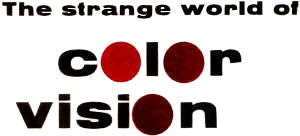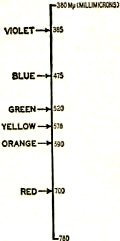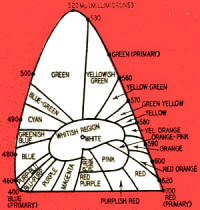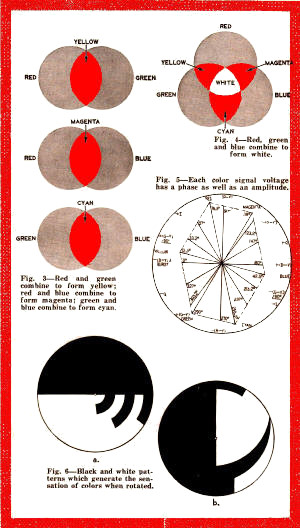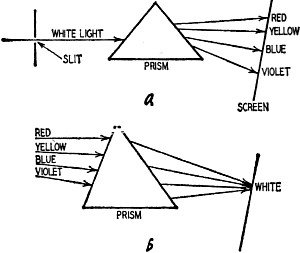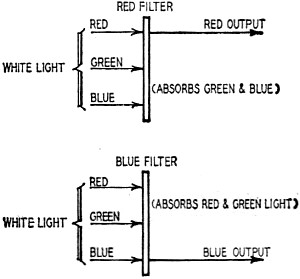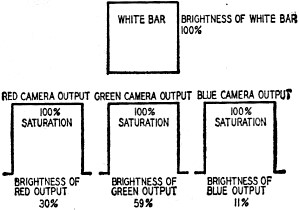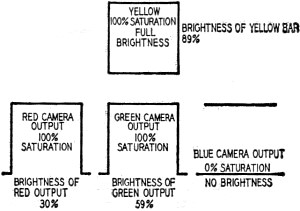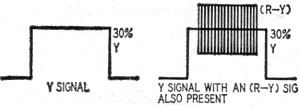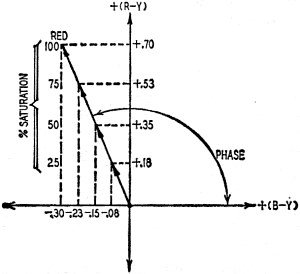The Strange World of Color Vision |
|||||||
Like so many things in life that we take for granted - aspirin, automatic clothes washers, drill motors and bits, eyeglasses, rifles, bicycles, transistors, to name a few - we rarely think about the effort that went behind the end product that is now enjoyed. Even relatively simple devices like scissors are the result of someone saying to himself or herself, "Self, I need something to make cutting fabric and paper and hair simpler and neater, so what might that thing look like?" Then, after making a working prototype, improvements are made based on empirical testing from usage, improvements are made in the form factor, materials, size, etc., until evolution results in what can be purchased today. If you have ever been in a product design cycle, either privately or corporately, then you know the process well. A concept as sophisticated as developing television is much more involved than developing a pair of scissors, but the fundamentals are the same. Implementing color TV for commercial broadcast had the dual difficulty of not just producing affordable and reliable color images, but also being backwards compatible with black and white (B&W) broadcasts and TV sets already in place. Adding stereo sound to the original monaural FM radio broadcasts had the same requirement. This article from a 1958 edition of Radio-Electronics does a superb job of describing the work that went into implementing color television. You might be as surprised as I was to learn how much new science was required in the realm of human vision and color perception in order to design a high quality transmission and presentation. Prior to color TV, most color perception research went into reflected light (paint, ink, crayons, etc.) whereas for the first time in human history it was necessary to determine the peculiarities of emitted light from a light source (cathode ray tube). The Strange World of Color Vision
By Robert G. Middleton Television Consultant Color is by no means simple - it is often incomprehensible and always tricky; but its apparent inconsistencies make compatible color television possible. Children and simple folk suppose that the colors they see really exist in nature and scoff at the idea that colors exist only in the mind. Physicists explain that the colors we see correspond to waves of electromagnetic energy from 4 to 8 X 1014 cycles per second. Electromagnetic waves used in radio and television transmission have longer wavelengths. Of course, light waves are not color, any more than radio waves are color. Physicists do not attempt to explain further and physiologists cannot. Psychologists are baffled and philosophers offer various theories which cannot be proved or disproved. In spite of the unsatisfactory state of our knowledge concerning color vision, many interesting laws have been discovered, upon which the technology of color television rests. Some of these laws are well known while others are familiar only to specialists. Trichromatic Vision Of all our body's organs, the eye is most remarkable. Loss of hearing is a personal tragedy but loss of sight is a calamity - our eyes provide us with more information concerning the external world than any other organ. It was once supposed that the eye is a frequency-sensitive organ because we see various colors when electromagnetic waves of various frequencies enter the eye. As shown in Fig. 1, a wavelength of 475 mμ (millimicrons, mμ) causes us to see blue, 520 mμ green, 578 mμ yellow and 700 mμ to see red. Fig. 1 shows in a limited manner the information given in Fig. 2. The chromaticity diagram (Fig. 2) shows around its border the wavelengths of light corresponding to the common colors. Note that there are colors along the base of the diagram to which no single wavelength of light corresponds. This is a rather unexpected fact which is discussed later in the article.
When we mix red light with green light, we do not see either of these two colors. Instead we see a new color: yellow. On this basis, we must abandon the definition that yellow corresponds to a wavelength of 578 mμ, since yellow is also produced by a combination of two other wavelengths. In fact, investigation has shown that the many thousands of colors which we see can be obtained by mixing only three colored lights - red, green and blue - in various proportions. Color television operates upon this law, the law of trichromatic vision. Fig. 3 illustrates how the primary colors of red, green and blue combine by pairs to form the complementary colors of yellow, cyan and magenta. Fig. 4 shows how the three primary colors combine to form white. To obtain compatible operation of black-and-white and color TV receivers, wavelengths of light are transmitted as various phase angles of a color subcarrier. This is shown in Fig. 5. Burst is taken as the reference frequency. Red, which has a wavelength of 700 mμ, is transmitted as a phase angle of 76.5°. Magenta, which is a combination of 700 mμ and 475 mμ, is transmitted as a phase angle of 119°. The colors seen in the spectrum of a prism are 100% saturated. They are pure colors. Saturated colors are vivid. Desaturated colors are pale - they have a pastel shade. The wavelength of a desaturated color is the same as the wavelength of the same saturated color. However, white light is mixed with a saturated color to make a desaturated color. In Fig. 5, the relative voltages of the saturated colors are shown by the lengths of the vectors. Now, if we shorten the length of the red vector to half that shown in Fig. 5, we transmit pink - a desaturated red. It is no mystery that hues are transmitted in terms of phase, and that saturations are transmitted in terms of voltage. These values are easily calculated throughout. We encounter the unknown only when we attempt to understand how a color such as yellow is seen when the eye is viewing a mixture of red and green lights. Perhaps we shall never know. Producing Color White is a mixture of red, green and blue. Black is the absence of visible electromagnetic wave energy. As white can be produced from colors, conversely, colors can be produced by suitable arrangements of black and white. For example, when we mount the disk shown in Fig. 6-a on the shaft of a variable-speed motor, we see an arc of color in the rotating pattern. As the speed of the motor is varied, the hue of the color changes accordingly. A disk which produces red and yellow is shown in Fig. 6-b. It is thought that there may be three types of color receptors in the retina of the eye, with peak responses to wavelengths in the regions of red, green and blue. These color receptors are not sharply tuned but have overlapping responses or considerable bandwidth. Furthermore, when these color receptors are simultaneously energized by white light which is then suddenly stopped, the response of the color receptors does not fall to zero at once, but requires a small time interval to decay to zero.
The known facts of "color blindness" also support the theory of three color receptors in the retina, responding in the regions of red, green and blue. Test charts are available, which reveal the presence of various types of color blindness in afflicted persons. Some persons are completely color-blind, but still get about quite handily, since black-and-white vision remains (provided by the rods in the retina) although the color receptors (cones) are incapable of response. All of us are color-blind in dim light. If you walk out of a lighted room into a dimly lit hall and look at a color chart, you will find that all the colors appear to be in shades of gray. We are also color-blind to very small patches of color and semi-color-blind to somewhat larger patches. All colors seem to drift into orange or cyan hues as a patch of the color is reduced in size. This is the I axis of color television and is the basis of wide-band color transmission. Development of the Eye In an embryonic infant, the retina develops as an outgrowth of the fore-brain. However, the function of vision is located in the hind-brain and persons who suffer injury to the hind-brain are as blind as if their eyes had been put out. If a person has the hind-brain intact, but his eyes have been injured, he may still see flashes of light and colors as a result of mechanical stimulation of the exposed ends of the optic nerves. A somewhat similar response is observed by normal persons. If the eyelids are closed and pressure is applied to the edge of the eyeball, rings of yellowish light are seen. How the sensation of light is produced in the mind when the optic nerves are energized is not known. As far as color television is concerned, it is essential only that we know the laws of color mixture whereby any desired color can be synthesized by a suitable mixture of the three primary colors. Fig. 7-a shows how a prism can decompose white light into a spectrum of its color components. Fig. 7-b shows how the color spectrum can be recombined into white light again. This is not a very striking demonstration. However, we find that we can remove large regions of the spectrum, leaving only the colors at the extreme ends and a color at the middle, and still obtain white on re-composition. This robbed white is quite undistinguishable by the human eye from the first white. If we were unable to rob the spectrum in this manner, color television as we know it today would be impossible. It is hard enough to transmit three primary-color signals in a 6-mc channel containing a black-and-white signal and sound signal without contending with individual signals for tens of thousands of particular hues. Robbing the Color Spectrum A rainbow spectrum of light is conveniently robbed by use of filters, as depicted in Fig. 8. Optical filters operate like electric or electronic filters, except that the resonant circuits utilized are contained in the electronic orbits of the atoms in the filter. All matter is an arrangement of electrical forces or fields. The electrons comprising a substance have a certain frequency of rotation about the nucleus of the atom and are coupled to external space just as an antenna is coupled to space. Incident electromagnetic energy can be absorbed by electrons in certain orbits, just as a tuned circuit absorbs electromagnetic energy from an antenna. Thus, an optical filter is an electronic wavetrap, of atomic dimensions, which is tuned to the frequency of the electromagnetic energy recognized by us as a given color. There is no basic difference between an optical filter and a wave trap except that the wavelengths used in the optical filter are shorter. Color can be specified on a technical basis in terms of brightness, hue and saturation. Fig. 9 shows that the brightness of a white bar is equal to the sum of the brightnesses of its components (red, green and blue). The brightness of red, as seen on a black-and-white picture tube, is 30%; the brightness of green is 59%; the brightness of blue is 11 % - hence, the brightness of white is 100%. Fig. 10 shows that the brightness of a color is equal to the sum of the brightnesses of its components. Yellow has a brightness, as seen on a black-and-white picture tube, of 89%. Yellow is comprised of green which has a brightness of 59% and of red which has a brightness of 30% - hence, the brightness of yellow is the sum of these brightnesses, or 89%. The brightness of a color, as transmitted from a color TV station, is given by the level of the Y (black-and-white) signal component, as shown in Fig. 11. To this brightness signal level is added a 3.58-mc chroma signal. The chroma signal specifies hue and saturation. Fig. 12 shows how the voltage of the chroma signal specifies the saturation (vividness) of the color. We have already seen how the phase of the chroma signal specifies color (hue). This particular (NTSC) signal arrangement has been established to provide compatibility in black-and-white and color TV reception. Fig. 13 shows how a succession of red, green and blue bars is transmitted as a series of video levels at 30%, 59% and 11%. This is the only part of the complete color signal which is seen by a black-and-white TV receiver. The chroma signal has a relatively high frequency (3.579545 mc) which is largely filtered out in the if and video amplifier of a black-and-white TV receiver. In a color TV receiver, however, the chroma signal component is not rejected, but is processed through the chroma circuits of the color receiver. The color receiver responds to the phase of the chroma signal by displaying a corresponding hue; it responds to the voltage of the chroma signal by displaying a corresponding color saturation. This is how we get compatibility. Color and Monochrome (B&W) Television Articles
Posted July 29, 2020 |
|||||||

